
S/V Mari Hal-O-Jen
Though we travel the world over to find the beautiful, we must carry it with us or we find it not. ~Ralph Waldo Emerson
31 December 2010
28 December 2010
23 December 2010
22 December 2010
21 December 2010
20 December 2010
16 December 2010
15 December 2010
14 December 2010
13 December 2010
10 December 2010
09 December 2010
08 December 2010
07 December 2010
06 December 2010
03 December 2010
02 December 2010
01 December 2010
24 November 2010
23 November 2010
Portuguese Man of War
30 November 2006 | Blue Waters Marina
Brainless, boneless, bloodless... blobs... successfully oceangoing for 650 million years. ~Lily Whiteman
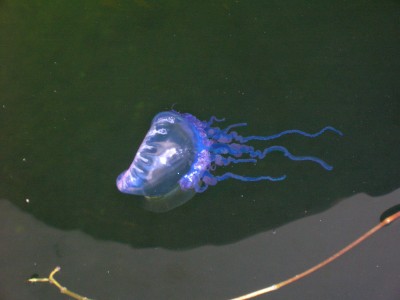
Stepping onto the deck this morning I saw the most brilliant, otherworldly thing floating by the boat. The colors of a Portuguese Man of War are vibrant. I find it amazing that these blues and purples are natural; they sure are definitely not common in the Animal Kingdom!
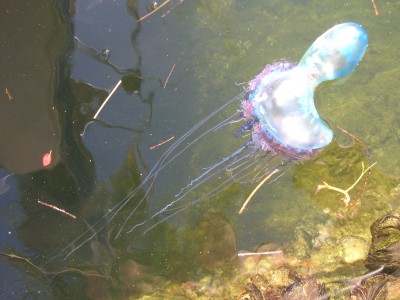
Looking around, I was shocked at how many were floating in the immediate vacinity. The increased wind from the east has blown a mat of grass and weed into the basin bringing with it many Man of Wars, or would that be Men of War? I've since read that mats of several thousand are common. What a sight that must be! I believe a large group of Jellyfish are called a Smack. I wonder if the same applies to Portuguese Man of War groupings?
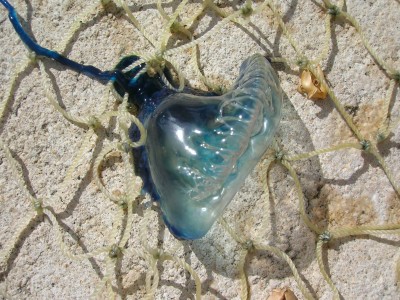
Quite a few were large, 6 - 8 inches along the float, but there were many, many smaller ones. While retrieving a piece of chafe gear that blew off our standing rigging Marianna came up with a smaller one we had not even noticed in the net. The float was very clear and cast a neat shadow on the ground. After returning it to the sea, we saw that where it had been resting on the cement it had left deep purple marks behind that easily hosed off.

I really thought that Portuguese Man of War were unable to move, apart from a tentacle or two for hunting. But while observing one alongside the seawall we watched it spin in a circle and then flip itself over. Research revealed that it must do so to keep the float wet. That float is an amazing thing! It is filled with a very rare gas, Argon, and can even be deflated if it needs to protect itself during rough weather.
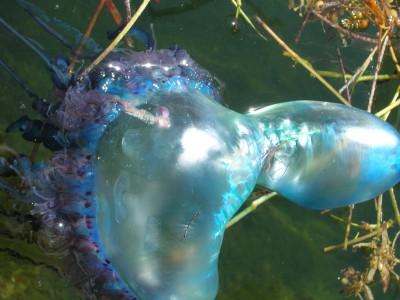
Humans need to be proactive in protecting themselves from the stings of Portuguese Man of War and others in the Cnidaria phylum including the
planktonic larva that we call hydroids and sea lice. So we tend to wear Safe Sea which is reportably good for preventing all jellyfish and sea lice stings except Box Jelly's and that is simply unproven as noone has volunteered to try it out with that species! In our own observations, wearing Safe Sea really works well but should be reapplied if the entire day is spent in the water.
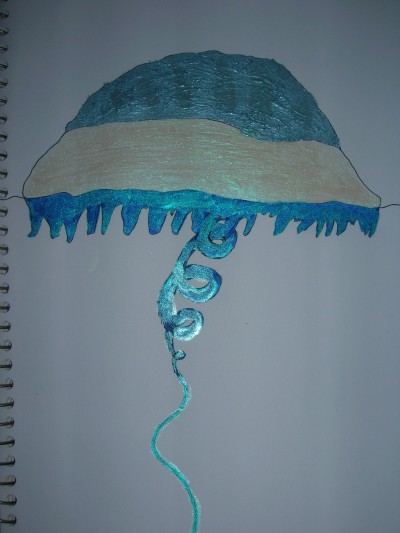
Marianna and I were quite inspired and enjoyed researching and sketching these beautiful creatures. The following is Marianna's report and pages from both our Nature Journals.
Lately we have been noticing quite a few Man o' War around the boat. All are young still but that does not mean that they don't still hurt if they sting. We even have a resident here that has been stung by one. He says they grab and tangle their tentacles around your body so its really hard to untangle them. They also stick to you like glue.
One did all that on a stick today. I was clearing the seaweed away from him and one of his tentacles caught the stick and tangled it all up in it. It was pretty hard to untangle it without breaking the tentacle.
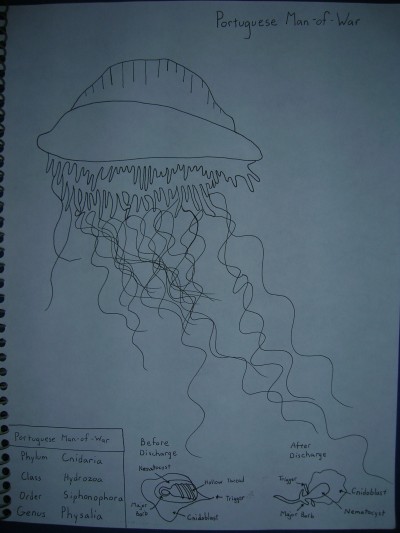
Portuguese Man O' War are often thought of as Jellyfish. They are in fact very different, here is the classification.
Kingdom : Animalia
Phylum: Cnidaria
Class: Hydrozoa
Order: Siphonophora
Family: Physaliidae
Genus: Physalia
Species: Physalia Physalis
Here is a Lion's Mane Jellyfish's classification
Kingdom Animalia,
Phylum Cnidaria,
Class Scyphozoa
Order Semaeostomeae
Family Cyaneidae
You can see they are in different Classes even though they might look sort of the same.
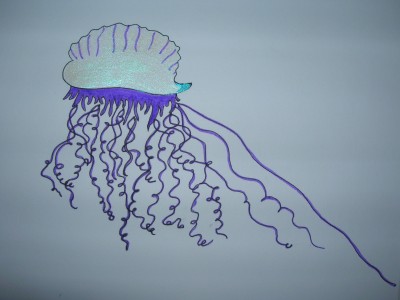
We do know they are a colonial hydroid, consisting of a large colony of smaller organisms. Each part has its own duty, such as reproduction, feeding, and defense. A Man O' War has four kinds of these parts (called polyps). Each of them is responsible for certain functions.
The float (or pneumatophore) supports the rest of the colony. The tentacles (dactylozooids) hunt for prey and when they capture something, they pass it on to the digestive polyps (gastrozooids). Reproduction of the colony is performed by the gonozooids, another type of polyp. We think they are hermaphrodites (both male and female in the gonozooid).
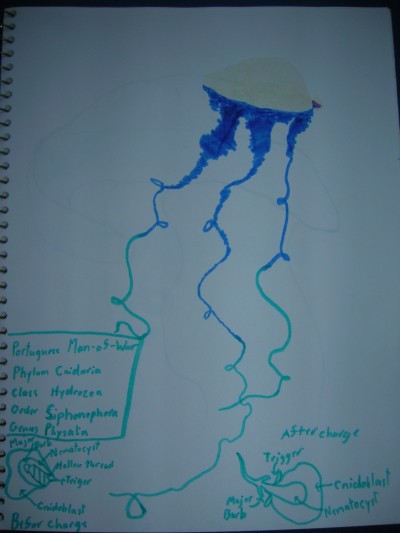
No one really knows how Portuguese Man O' War reproduce, but we do know there are two ways. First is with a fertilized egg that develops into a planktonic larval form which then produces the large Physalia colony by something called asexual budding which is like a strawberry plant making more strawberry plants with runners.
A good thing to do is to recognize them so you won' t get stung. Portuguese Man O' War look like bluish/purplish bags with a seam. Their tentacles float far from their body, up to 165 feet away, so stay as far away as possible.
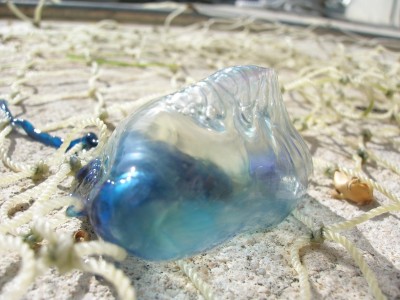
Kidzworld
Wikipedia

Looking around, I was shocked at how many were floating in the immediate vacinity. The increased wind from the east has blown a mat of grass and weed into the basin bringing with it many Man of Wars, or would that be Men of War? I've since read that mats of several thousand are common. What a sight that must be! I believe a large group of Jellyfish are called a Smack. I wonder if the same applies to Portuguese Man of War groupings?

Quite a few were large, 6 - 8 inches along the float, but there were many, many smaller ones. While retrieving a piece of chafe gear that blew off our standing rigging Marianna came up with a smaller one we had not even noticed in the net. The float was very clear and cast a neat shadow on the ground. After returning it to the sea, we saw that where it had been resting on the cement it had left deep purple marks behind that easily hosed off.

I really thought that Portuguese Man of War were unable to move, apart from a tentacle or two for hunting. But while observing one alongside the seawall we watched it spin in a circle and then flip itself over. Research revealed that it must do so to keep the float wet. That float is an amazing thing! It is filled with a very rare gas, Argon, and can even be deflated if it needs to protect itself during rough weather.

Humans need to be proactive in protecting themselves from the stings of Portuguese Man of War and others in the Cnidaria phylum including the
planktonic larva that we call hydroids and sea lice. So we tend to wear Safe Sea which is reportably good for preventing all jellyfish and sea lice stings except Box Jelly's and that is simply unproven as noone has volunteered to try it out with that species! In our own observations, wearing Safe Sea really works well but should be reapplied if the entire day is spent in the water.

Marianna and I were quite inspired and enjoyed researching and sketching these beautiful creatures. The following is Marianna's report and pages from both our Nature Journals.
Lately we have been noticing quite a few Man o' War around the boat. All are young still but that does not mean that they don't still hurt if they sting. We even have a resident here that has been stung by one. He says they grab and tangle their tentacles around your body so its really hard to untangle them. They also stick to you like glue.
One did all that on a stick today. I was clearing the seaweed away from him and one of his tentacles caught the stick and tangled it all up in it. It was pretty hard to untangle it without breaking the tentacle.

Portuguese Man O' War are often thought of as Jellyfish. They are in fact very different, here is the classification.
Kingdom : Animalia
Phylum: Cnidaria
Class: Hydrozoa
Order: Siphonophora
Family: Physaliidae
Genus: Physalia
Species: Physalia Physalis
Here is a Lion's Mane Jellyfish's classification
Kingdom Animalia,
Phylum Cnidaria,
Class Scyphozoa
Order Semaeostomeae
Family Cyaneidae
You can see they are in different Classes even though they might look sort of the same.

We do know they are a colonial hydroid, consisting of a large colony of smaller organisms. Each part has its own duty, such as reproduction, feeding, and defense. A Man O' War has four kinds of these parts (called polyps). Each of them is responsible for certain functions.
The float (or pneumatophore) supports the rest of the colony. The tentacles (dactylozooids) hunt for prey and when they capture something, they pass it on to the digestive polyps (gastrozooids). Reproduction of the colony is performed by the gonozooids, another type of polyp. We think they are hermaphrodites (both male and female in the gonozooid).

No one really knows how Portuguese Man O' War reproduce, but we do know there are two ways. First is with a fertilized egg that develops into a planktonic larval form which then produces the large Physalia colony by something called asexual budding which is like a strawberry plant making more strawberry plants with runners.
A good thing to do is to recognize them so you won' t get stung. Portuguese Man O' War look like bluish/purplish bags with a seam. Their tentacles float far from their body, up to 165 feet away, so stay as far away as possible.

Kidzworld
Wikipedia
Comments
| Vessel Make/Model: | 35' Coronado |
| Hailing Port: | Boca Chica |
| Crew: | Capt. Hal, Jennifer, and our daughter Marianna, a great photographer! |
| Extra: | Warmest Wishes! |
| Home Page: | http://www.sailblogs.com/member/marihalojen/ |
Gallery not available
S/V Mari Hal-O-Jen
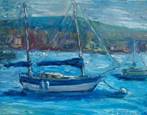
Who: Capt. Hal, Jennifer, and our daughter Marianna, a great photographer!
Port: Boca Chica
Contents
Our Favorites
- Mari Hal-O-Jen Photo Gallery
- Local Doppler Radar
- NOAA's Online Chart Viewer
- Seven Seas Cruising Association
- Noonsite
- SOUTHWINDS
- Kids Aboard
- Small Meadows Press
- 4 Real Forums
- A Short Digital Camera Course
- Brave Writer
- Penny Gardner's Site
- Sunschoolers
- Rising Phoenix (Marianna's Blog)
- APRIL'S SHOWER OF PHOTOS
- "Go East", they said...
- A Shower of Roses
- Amy In Stitches
- and these Thy gifts...
- As We Walk
- By Sun and Candlelight
- Five Monkeys and a Princess
- Handbook of Nature Study
- In the Heart of My Home
- Inside My Domestic Church
- Island in the Grove
- Joyful Chaos
- Just Another Day in Paradise
- LaPaz Home Learning
- Lettres de Mon Moulin
- Little House in the Big Yard
- Moments Like These
- Our Domestic Church
- Our Hearts' Haven
- Parente Adventures
- Pondered in my Heart
- Running with Perseverance
- Seven Little Australians Plus One
- Shower of Roses
- Sonlight Garden
- Spiritbee
- Sweetness and Light
- Ten Kids and a Dog
- The Bookworm
- The Cabbage Patch
- The Family-Centered Life
- This Blessed Mess
- Three Plus Two
- Totus Tuus Family
- Trapper Creek
- Posy
- Soule Mama












